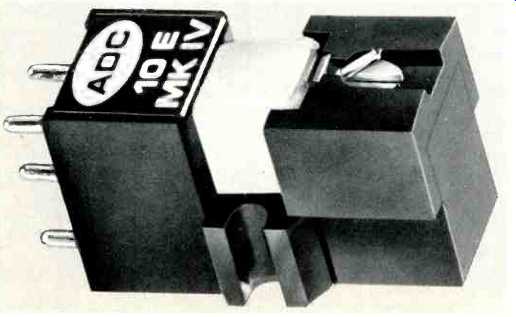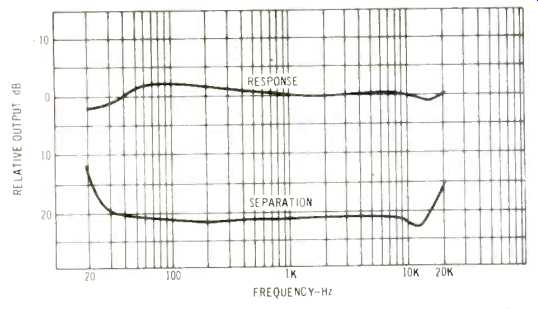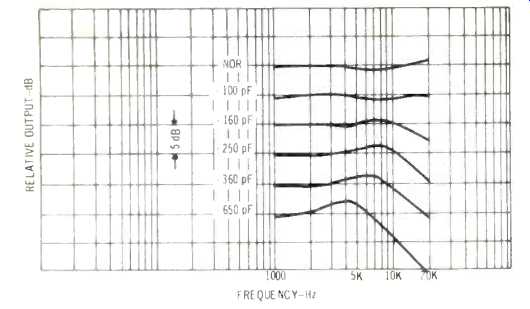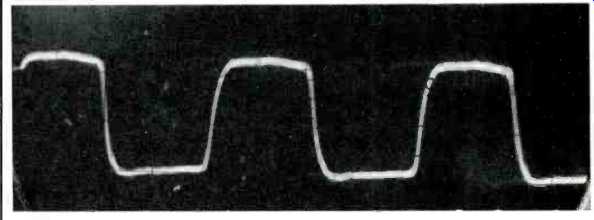
MANUFACTURER'S SPECIFICATIONS
Type: Induced magnet.
Output: 4 mV at 5.5 cm/sec recorded velocity.
Tracking Force: 0.7 gram.
Frequency Response: 10 Hz to 20 kHz ±2 dB.
Channel Separation: 30 dB from 50 Hz to 12 kHz.
Compliance: 35 x 10 3/4 cm/dyne.
Elliptical Stylus Tip: Contact radius, .0003 in.; lateral radius, .0007 in.
IM Distortion: Less than 0.5%--400 & 4000 Hz at 14.3 cm/sec recorded velocity.
Vertical Tracking Angle: 15 deg.
Recommended Load Impedance: 47,000 ohms nominal.
Price: $50.00.

While similar in appearance to the earlier Models 25 and the single-stylus version, the Model 26, the 10E MK IV differs in several categories. Both the newest model and the earlier ones employed the "induced magnet" arrangement--in which the stylus does not move a permanent magnet which has an appreciable mass but moves instead a soft iron collar which moves between the pole pieces and induces a flux in them-the MK IV is designed for a fixed stylus force. This undoubtedly simplifies the design, since compromises are not required to permit operation over a stylus force ranging from 0.5 to 1.5 grams. In addition, this allows the designer to reduce the stylus restoring force to a minimum commensurate with the fixed stylus force. This does not mean that the cartridge will not operate at other stylus forces, but only that performance specifications are obtained with the rated value.
It does mean, however, that the cartridge should not be used with low-quality record playing equipment, which is, after all, a logical way to build up a system anyway--you don't put General Dual 90 tires on a 1932 Packard. You do need a pretty good changer or arm in order for the performance to be reliable at a stylus force of as low as 0.7 grams.
However, there are plenty of current models of automatic turntables, as well as of separate arms, that will work perfectly under this condition.
Since the magnet is not part of the stylus assembly, a larger magnet can be used, and such is the case in the MK IV. It is enclosed in the molded housing, along with the tiny pole pieces and the coils, and still provides space for adequate shielding. The stylus assembly is enclosed in a U-shaped plastic molding which slips over the body of the cartridge and holds the soft iron ring in precise alignment with the four pole-pieces. The stylus assembly is at the 15-deg. vertical tracking angle at which all modern LP records are cut.
Performance

Fig. 1--Frequency response and separation curves for the ADC 10E Mk IV.

Fig. 2--Curves showing the effect of added capacitance across the output
of the ADC 1OE Mk IV. Note that there is little difference until the added
capacitance exceeds 160 pF.
Figure 1 shows the frequency response and the separation as an average between the two channels--which differed by less than 1 dB throughout the range from 20 to 20,000 Hz.
Response was well within the ± 2-dB specification over the entire range, and within ± 1 dB from 300 to 15,000 Hz.
Separation was better then 20 dB from 40 Hz to 15 kHz, dropping to an excellent 15 dB at 20 kHz.
Since the manufacturer suggests that the connecting cables be not longer than 5 feet, we measured frequency response with several additional values of capacitance corresponding to longer-than-normal connecting cables between cartridge and amplifier. The normal value of our connecting cable was measured at 145 pF, and we made frequency response measurements with additional values of 100 pF, 160 pF, 250 pF, 360 pF, and a whopping 650 pF, with the results plotted in Fig. 2. We have long known of the effect of additional capacitance in reducing high-frequency peaks in cartridges, usually with a slight build-up of response in the 5000to 8000-Hz ranges. It is not uncommon for manufacturers to specify the preferred value for load capacitance for flattest response.
The 10E MK IV does not show much of a droop in the 5000 to 8000-Hz range, so often encountered in some other models, and the effect of additional capacitance is only slightly noticeable until the extra loading reaches 160 pF, which would correspond to a cable length of 10 to 12 feet. This amount of connecting cable should certainly be avoided, if only to reduce the possibility of hum pickup in the leads.
At the specified 0.7-gram stylus force, there was no trouble in tracking the test 100-Hz groove cut with an amplitude of .005 in., which is a level not usually encountered in most records.

Fig. 3--Square wave response of the ADC 10E Mk IV.
Square-wave response, using the CBS STR-111 test record, is shown in Fig. 3, a fairly clean, smooth trace. IM distortion was measured, using the 200/4000 bands on the CBSSTR-110 record, resulting in a distortion of 0.6 per cent at the +9 dB level-the band used heretofore in reporting lateral IM distortion. Similarly for vertical IM distortion, we have heretofore reported the same 200/4000 section--more critical than the 400/4000 bands--and at the +6-dB level we noted a distortion of 1.8 percent. All of these distortion figures are low in comparison with many other cartridges.
The crucial test of any cartridge is in the listening, of course, as it is with any high fidelity component. We could find no complaint with its sound-silky and smooth in the high end and solid in the bass. We tried it with several different types of music, and would readily welcome the MK IV in any system. It was installed in a high-quality automatic turntable, as it should be in any user's system, and its performance was flawless.
-C. G. McProud
(Audio magazine, Dec. 1972)
Also see:
ADC (Audio Dynamics) XLM Stereo Cartridge (Jul. 1972)
ADC Model LMF-2 Tonearm & ZLM Phono Cartridge (Equip. Profile, Jan. 1979)
ADCOM Crosscoil XC/VAN DEN HUL Moving-Coil Phono Cartridge (Jan. 1982)
Decca London International Tonearm & Mk VI Gold Elliptical Phono Cartridge (Aug. 1979)
ADC Model 303AX Loudspeaker System (Jan. 1970)
= = = =